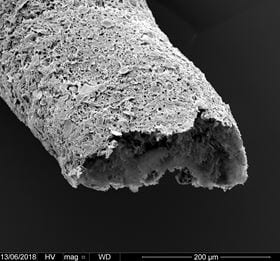Close-up of a tubular structure made by simultaneous printing and self-assembly of graphene oxide and a protein. Image: Professor Alvaro Mata. An international team of scientists, led by Alvaro Mata at the University of Nottingham and Queen Mary University London in the UK, has discovered a new material that can be 3D printed to create tissue-like vascular structures. In a paper in Nature Communications , the scientists report developing a way to 3D print graphene oxide with a protein that can organize into tubular structures that replicate some of the properties of vascular tissue. "This work offers opportunities in biofabrication by enabling simultaneous top-down 3D bioprinting and bottom-up self-assembly of synthetic and biological components in an orderly manner from the nanoscale," said Mata. "Here, we are biofabricating micro-scale capillary-like fluidic structures that are compatible with cells, exhibit physiologically relevant properties, and have the capacity to withstand flow. This could […]
Click here to view original web page at www.materialstoday.com





0 Comments